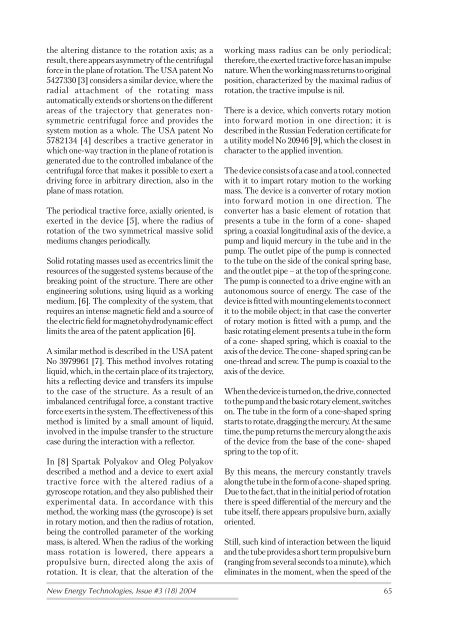Issue 17 - Free-Energy Devices
Issue 17 - Free-Energy Devices
Issue 17 - Free-Energy Devices
You also want an ePaper? Increase the reach of your titles
YUMPU automatically turns print PDFs into web optimized ePapers that Google loves.
the altering distance to the rotation axis; as a<br />
result, there appears asymmetry of the centrifugal<br />
force in the plane of rotation. The USA patent No<br />
5427330 [3] considers a similar device, where the<br />
radial attachment of the rotating mass<br />
automatically extends or shortens on the different<br />
areas of the trajectory that generates nonsymmetric<br />
centrifugal force and provides the<br />
system motion as a whole. The USA patent No<br />
5782134 [4] describes a tractive generator in<br />
which one-way traction in the plane of rotation is<br />
generated due to the controlled imbalance of the<br />
centrifugal force that makes it possible to exert a<br />
driving force in arbitrary direction, also in the<br />
plane of mass rotation.<br />
The periodical tractive force, axially oriented, is<br />
exerted in the device [5], where the radius of<br />
rotation of the two symmetrical massive solid<br />
mediums changes periodically.<br />
Solid rotating masses used as eccentrics limit the<br />
resources of the suggested systems because of the<br />
breaking point of the structure. There are other<br />
engineering solutions, using liquid as a working<br />
medium. [6]. The complexity of the system, that<br />
requires an intense magnetic field and a source of<br />
the electric field for magnetohydrodynamic effect<br />
limits the area of the patent application [6].<br />
A similar method is described in the USA patent<br />
No 3979961 [7]. This method involves rotating<br />
liquid, which, in the certain place of its trajectory,<br />
hits a reflecting device and transfers its impulse<br />
to the case of the structure. As a result of an<br />
imbalanced centrifugal force, a constant tractive<br />
force exerts in the system. The effectiveness of this<br />
method is limited by a small amount of liquid,<br />
involved in the impulse transfer to the structure<br />
case during the interaction with a reflector.<br />
In [8] Spartak Polyakov and Oleg Polyakov<br />
described a method and a device to exert axial<br />
tractive force with the altered radius of a<br />
gyroscope rotation, and they also published their<br />
experimental data. In accordance with this<br />
method, the working mass (the gyroscope) is set<br />
in rotary motion, and then the radius of rotation,<br />
being the controlled parameter of the working<br />
mass, is altered. When the radius of the working<br />
mass rotation is lowered, there appears a<br />
propulsive burn, directed along the axis of<br />
rotation. It is clear, that the alteration of the<br />
New <strong>Energy</strong> Technologies, <strong>Issue</strong> #3 (18) 2004<br />
working mass radius can be only periodical;<br />
therefore, the exerted tractive force has an impulse<br />
nature. When the working mass returns to original<br />
position, characterized by the maximal radius of<br />
rotation, the tractive impulse is nil.<br />
There is a device, which converts rotary motion<br />
into forward motion in one direction; it is<br />
described in the Russian Federation certificate for<br />
a utility model No 20946 [9], which the closest in<br />
character to the applied invention.<br />
The device consists of a case and a tool, connected<br />
with it to impart rotary motion to the working<br />
mass. The device is a converter of rotary motion<br />
into forward motion in one direction. The<br />
converter has a basic element of rotation that<br />
presents a tube in the form of a cone- shaped<br />
spring, a coaxial longitudinal axis of the device, a<br />
pump and liquid mercury in the tube and in the<br />
pump. The outlet pipe of the pump is connected<br />
to the tube on the side of the conical spring base,<br />
and the outlet pipe – at the top of the spring cone.<br />
The pump is connected to a drive engine with an<br />
autonomous source of energy. The case of the<br />
device is fitted with mounting elements to connect<br />
it to the mobile object; in that case the converter<br />
of rotary motion is fitted with a pump, and the<br />
basic rotating element presents a tube in the form<br />
of a cone- shaped spring, which is coaxial to the<br />
axis of the device. The cone- shaped spring can be<br />
one-thread and screw. The pump is coaxial to the<br />
axis of the device.<br />
When the device is turned on, the drive, connected<br />
to the pump and the basic rotary element, switches<br />
on. The tube in the form of a cone-shaped spring<br />
starts to rotate, dragging the mercury. At the same<br />
time, the pump returns the mercury along the axis<br />
of the device from the base of the cone- shaped<br />
spring to the top of it.<br />
By this means, the mercury constantly travels<br />
along the tube in the form of a cone- shaped spring.<br />
Due to the fact, that in the initial period of rotation<br />
there is speed differential of the mercury and the<br />
tube itself, there appears propulsive burn, axially<br />
oriented.<br />
Still, such kind of interaction between the liquid<br />
and the tube provides a short term propulsive burn<br />
(ranging from several seconds to a minute), which<br />
eliminates in the moment, when the speed of the<br />
65
















